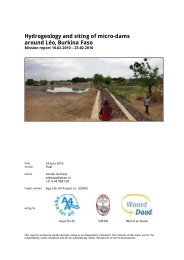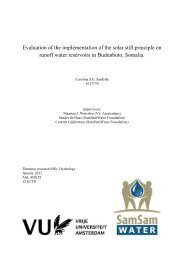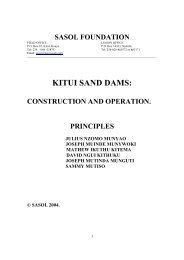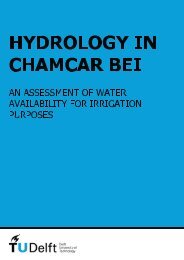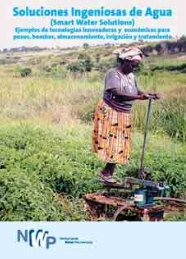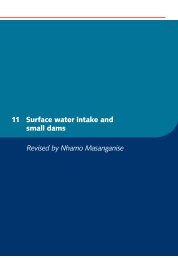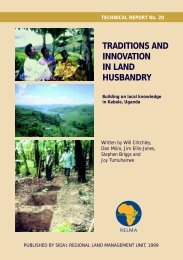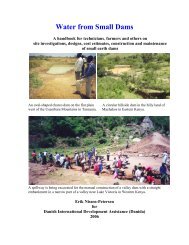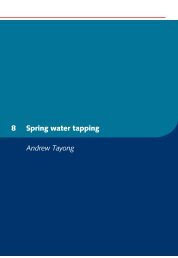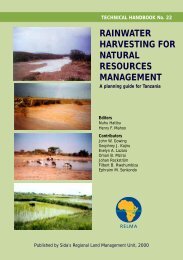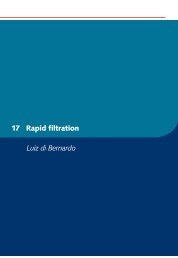Coagulation and flocculation - SamSamWater
Coagulation and flocculation - SamSamWater
Coagulation and flocculation - SamSamWater
You also want an ePaper? Increase the reach of your titles
YUMPU automatically turns print PDFs into web optimized ePapers that Google loves.
14 <strong>Coagulation</strong> <strong>and</strong> <strong>flocculation</strong>Update by Ken IvesSpecial contribution fromSamia Al Azharia Jahn
14<strong>Coagulation</strong> <strong>and</strong> <strong>flocculation</strong>14.1 Introduction<strong>Coagulation</strong> <strong>and</strong> <strong>flocculation</strong> provide the water treat-ment process by which finely dividedsuspended <strong>and</strong> colloidal matter in the water is made to agglomerate <strong>and</strong> form flocs. Thisenables their removal by sedi-mentation, dissolved air flotation or filtration. Colloidalparticles (colloids) are midway in size 1 between dissolved solids <strong>and</strong> suspended matter.Colloids are kept in suspension (stabilised) by electrostatic repulsion <strong>and</strong> hydration.Electrostatic repulsion occurs because colloids usually have a surface charge due to thepresence of a double layer of ions around each particle. Thus, the colloid has an electriccharge, mostly a negative one. Hydration is the reaction of particles at their surface with thesurrounding water. The resulting particle-water agglomerates have a specific gravity, whichdiffers little from that of water itself.The substances that frequently are to be removed by coagulation <strong>and</strong> <strong>flocculation</strong> are thosethat cause turbidity <strong>and</strong> colour. Surface waters in tropical countries often are turbid <strong>and</strong>contain colouring material. Turbidity may result from soil erosion, algal growth oranimal/vegetable debris carried by surface run-off. Substances leached from decomposedorganic matter, leaves, or soil such as peat may impart colour. Both turbidity <strong>and</strong> colour aremostly present as colloidal particles.The electrostatic repulsion between colloidal particles effectively cancels out the electronicattraction forces (Van der Waals’ forces) that would attach the particles together. Certainchemicals (called coagulating agents, coagulants) have the capacity to compress the doublelayer of ions around the colloidal particles. They reduce the range of the electrostaticrepulsion, <strong>and</strong> thus enable the particles to flocculate, i.e. to form flocs. These flocs can growto a sufficient size <strong>and</strong> specific weight to allow their removal by settling, flotation or filtration.Generally water treatment processes involving the use of chemicals are not so suitable forsmall community water supplies. They should be avoided whenever possible. Chemicalcoagulation <strong>and</strong> <strong>flocculation</strong> should only be used when the needed treatment result cannotbe achieved with another treatment process using no chemicals. If the turbidity <strong>and</strong> colourof the raw water are not much higher than is permissible for drinking water, it should bepossible to avoid chemical coagulation in the treatment of the water. A process such as slows<strong>and</strong> filtration or multi-stage filtration would serve both to reduce the turbidity <strong>and</strong> colourto acceptable levels, <strong>and</strong> to improve the other water quality characteristics, in a single unit.A roughing filter can serve to reduce the turbidity load on the slow s<strong>and</strong> filter, if necessary.1 Size range: 5 x 10 -3 – 2.10 -1 micrometer (0.2 microns)296
Chapter 1414.2 CoagulantsAlum (Al2(SO4)3.nH20) where n=14, 16, or 18, depends on the form of alum supplied. Thismay be in liquid solution, broken crystalline granules 2-5 cm size (kibbled) or crystallineblocks. It is by far the most widely used coagulant. Iron salts (e.g. ferric chloride (FeCl3), orferric sulphate (Fe2(SO4)3.9H2O) can be used as well <strong>and</strong> in some instances haveadvantages over alum. A significant advantage of iron salts over aluminium is the broaderpH 2 range for good coagulation. Thus, in the treatment of soft coloured waters wherecolour removal is best obtained at low pHs, iron salts may be preferred as coagulants. Ironsalts should also be considered for coagulation at high pHs, since ferric hydroxide is highlyinsoluble in contrast to aluminium salts, which form soluble aluminate ions at high pHs.Sodium aluminate is mostly used for coagulation at medium pHs. Synthetic organicpolyelectrolytes have become available as coagulants but are generally not economical forsmall water supply systems, nor are they readily available.The use of extracts from the crushed seeds of certain tropical trees is described in detailin the next section, 14.3.Coagulants such as soluble aluminium <strong>and</strong> iron salts react with the alkalinity of thewater, <strong>and</strong> hydrolyse in it. For example, alum reacts to form aluminium-hydroxide floc,Al(OH)3, a gelatinous precipitate. The required alkalinity may be naturally present in thewater or it has to be added through dosage of lime, Ca(0H)2 or sodium carbonate,Na2CO3 (also called soda ash).For good coagulation the optimal dose of coagulant should be fed into the water <strong>and</strong>quickly <strong>and</strong> properly mixed with it. The optimal dose will vary depending upon thenature of the raw water <strong>and</strong> its overall composition. It is not possible to compute theoptimal coagulant dose for a particular raw water. A laboratory experiment called the jartest is generally used for the periodic determination of the optimal dose.The jar test may be briefly described as follows:A series of samples of water are placed on a special multiple stirrer <strong>and</strong> the samples,typically 800 ml in 1-litre beakers (or jars), are dosed with a range of coagulant, e.g. 10,20, 30, 40 <strong>and</strong> 50 mg/l, <strong>and</strong> are stirred vigorously for about one minute. Then followsa gentle stirring (10 minutes), after which the samples are allowed to st<strong>and</strong> <strong>and</strong> settle for30-60 minutes. The samples are then examined for colour <strong>and</strong> turbidity <strong>and</strong> the lowestdose of coagulant that gives satisfactory clarification of the water is noted.2 Measure of the acidity/alkalinity of water. Acid water has a pH below 7, the pH of alkaline water is higherthan 7.297
A second test involves the preparation of samples with the pH adjusted so that thesamples cover a range (e.g. pH = 5, 6, 7 <strong>and</strong> 8). The coagulant dose determinedpreviously is added to each beaker. Then follows stirring, <strong>flocculation</strong> <strong>and</strong> settlement asbefore. After this, the samples are examined <strong>and</strong> the optimum pH is determined. Ifnecessary, a re-check of the minimum coagulant dose can be done.Fig. 14.1. pH zone-coagulation relationship(Adapted from R.F. Packham)As mentioned earlier, aluminium <strong>and</strong> iron salts have considerable differences in their pHzones of good coagulation. For alum the pH zone for optimum coagulation is quitenarrow, ranging from about 6.5-7.5. The comparable range for ferric sulphate isconsiderably broader, a pH range of about 5.5-9.0 (Fig. 14.1). When the results of a jartest are plotted, this type of curve is typical.The most common method of dosing the alum or ferric sulphate is in the form ofa solution. Such a solution (usually of 3-7% strength, that is, 30-70 kg alum Al2(SO4)3.14H2O per m 3 water) is prepared in special tanks with a holding capacity of ten or morehours coagulant feeding requirements. Two tanks are required, one in operation, whilethe solution is being prepared in the other.When using alum, one should keep in mind that in solutions of less than 1% strength,the chemical is hydrolysed (i.e. forms agglomerates with the chemical feed water) beforeit is dosed into the raw water. To prevent this, the solution should always havea strength of more than 1.5%.298
Chapter 14Fig. 14.2. Chemical feed arrangement for alumVarious chemical feed arrangements can be used. Figure 14.2 shows an example.The simplest method of using lime is in the form of a suspension led into a special tank(called a lime saturator), to produce a saturated solution of calcium hydroxide. The sizeof the tank depends on the required lime dosage.14.3 <strong>Coagulation</strong> <strong>and</strong> <strong>flocculation</strong> with extracts of particular seedsSpecial contribution from Dr. Samia Al Azharia Jahn, Water Treatment AdviserBotanical identificationEarly attempts at water coagulation with plant materials arose through “self-help” bypoor people who had no access to groundwater. In India the seeds of Strychnospotatorum (table 14.1) have been used to clarify turbid water since the first centuriesAD. Where this wild tree was not available, kernels of Prunus species <strong>and</strong> seeds oflegumes (Papilionoidea) became substitutes. In the Northern Sudan, seeds of Moringaoleifera were tried out instead of beans <strong>and</strong> groundnuts. A relationship between thebotanical type <strong>and</strong> a content of coagulants (chemotaxonomy) could be detected forseveral plant genera <strong>and</strong> families.299
Table 14.1 Seed extracts that contain outst<strong>and</strong>ing natural coagulants 1PlantChemical nature ofcoagulantRaw water, turbidityrange, applicationStrychnos potatorum mannogalactan, Jamuna River (India):(clearing nut)probably anionic ca. 200-2200 NTU,polyelectrolyte recommended ascoagulant aidMoringa oleifera basic polypeptides White Nile (Sudan):(horseradish tree) cationic polyelectrolyte 50-250 NTU; Blue Nile:> 30 NTU-severalthous<strong>and</strong> NTU, fastacting primary coagulantMoringa stenopetala similar basicperformance likepolypeptidesMoringa oleiferafive other species of not yet known performance likeMoringaMoringa oleiferaVicia fabanot knownBlue Nile: > 800 NTU(broad bean)slow acting primarycoagulantPrunus armeniaca not knownRiver Nile, Egypt(apricot) 2 , <strong>and</strong>P.amygdalis (almond) not knownChangjiang, ChinaPrunus persica (peach) not known Oranje River, Lesothorivers of Potosí BoliviaReferenceBulusu <strong>and</strong> Sharma1965Jahn 1986, 1988Jahn 1986, 1988Jahn 1986, 1988Jahn 1986, 1988Alpino 1591, d’Arcet1838,Lu Yu 1170Offringa 1993,Soliz Rodriguez 19841 For details <strong>and</strong> bibliography cf. Jahn 1986, 1988, 19942 Apricot kernels were in Egypt, North Sudan <strong>and</strong> Sichuan (China) still in use in the 20th centuryChemical composition <strong>and</strong> toxicologyCertain seeds contain substances for the growth of the seedling, which also haveflocculating properties. The polyelectrolytes of Moringa oleifera, M. stenopetala <strong>and</strong>Strychnos potatorum are examples of such flocculating substances (table 14.1).The destabilisation of water colloids is due to positive or negative charges. The cationicelectrolytes of Moringa are presumed to act like cations of metal coagulants. Alum <strong>and</strong>a seed extract different impacts on several chemical <strong>and</strong> physical characteristics ofcoagulation (table 14.2). Moringa seeds contain seed oil <strong>and</strong> a germicide. The smell <strong>and</strong>taste effect on the water is very small, even for the maximum Moringa seed dose (200-250mg/l). In the low range of the optimal doses there is no germicide effect <strong>and</strong> there are norisks from toxic substances. The possible health effects from toxic substances in Strychnospotatorum seeds <strong>and</strong> Prunus kernels have not been investigated yet (Jahn, 1988, 1994).300
Chapter 14Table 14.2 Differences between water coagulation with alum <strong>and</strong> Moringa oleifera seed extractParameters Aluminium sulphate Moringa seed extractDestabilisation Al 3+ cationic polyelectrolytesSupport of aggregation adsorption at Al(OH)3 flocs noneEfficiency at low turbidity still satisfactory at 3 NTU failing below 30 NTUMineralogical nature ofsuspended matterminor impact on optimal doses doses about 50% lower ifmontmorillonite clays arepresent (Blue Nile)Pollution by organic matter minor impact on optimal doses great impact on doses <strong>and</strong>additional organic loadFloccoarse due to aluminiumhydroxidesvery fine; result is slowersettling; further decrease ofsettling at lower temperatureSludge volumegreatsmallpH of treated waterincrease of acidity (effect of SO4 2- ) no changeHardnessincrease of Ca 2+ due toneutralisationno changePreparation <strong>and</strong> application of Moringa seed coagulantsSeed qualityOnly ripe Moringa oleifera seeds (with brown seed coat) give a high coagulant efficiency(Jahn, 1986). Improper treatment of the seeds leads to loss of coagulation capacity.It can be prevented if collection <strong>and</strong> treatment is done by agro-foresters or trainedwomen <strong>and</strong> by using correct equipment.Turbidity rangeExperiences with seed coagulation relate to highly turbid waters only. If optimal doses<strong>and</strong> proper stirring are applied, seed extracts of Moringa oleifera can also reduce lowturbidity levels to 5-10 NTU after one hour of settling. For raw water with turbiditybelow 30 NTU, alum is superior in performance (table 14.2). Thus, surface waters withvarying turbidity (below 30 NTU for certain periods of the year) cannot always betreated adequately with seed extracts alone but need coagulant aids during such lowturbidity periods. Use of coagulant aids is not feasible at household level.Chemical water qualitySeed coagulants are more sensitive than alum to the mineralogical composition ofsuspended matter. Waters polluted by organic matter are only suitable for long-termtreatment as long as the required seed coagulant dose is less than 250 mg/l. This is forboth economic <strong>and</strong> microbiological considerations.301
Climatic factorsSeed coagulants are mainly applicable as primary coagulants for tropical <strong>and</strong> subtropicalcountries. At low temperatures the settling of the fine flocs (table 14.2) is too slow <strong>and</strong>incomplete, unless seed treatment is combined with other coagulants.Removal of pathogensLike alum, Moringa seed extracts achieve a removal of faecal coliforms of more than98% under optimal conditions. However, if the residual turbidity is more than 30-40NTU, the treated water still has the same contamination as raw water. Therefore,optimal dosing is required for small plants <strong>and</strong> for household application.Determination of optimal dosesSimplified (“village”) jar tests are a convenient alternative where the usual measurementscannot be afforded or electricity is not available. Special devices have been designed forstirring the seed coagulant at plant level. A seed coagulant suspension has differentreaction properties than a solution of a purified chemical such as alum. The coagulantefficiency is strongly reduced by shortening the time needed for thorough mixing of theseed extract with turbid water.Involvement of women, teachers <strong>and</strong> commerceAsian <strong>and</strong> African women from the lower classes are mainly responsible for thediscovery of seed extracts as coagulants for turbid water. Lack of knowledge onapplication has limited the possible improvement of water quality. Water coagulation athousehold level cannot be learned from a demonstration alone. Therefore, theinvolvement of teachers or commercial outlets is required to help the women indetermining the optimal seed coagulant dose, <strong>and</strong> to distribute or sell st<strong>and</strong>ard solutionsof the seed coagulant.Socio-economic challengesSince Moringa oleifera is a multipurpose tree, certain economic interests may endangerlong-term uses of seed extracts for water coagulation. Sometimes people prefer to havethe fruit trees in their own gardens rather than on community l<strong>and</strong>s (women then haveno right to harvest the seeds). There may also be a commercial preference to sell greenMoringa pods as a delicacy to urban customers or factories. On the other h<strong>and</strong>, removalof the seed oil for other uses <strong>and</strong> application of press cake extracts instead of seedextracts has been tried out in small plants of Malawi <strong>and</strong> Tanzania (Folkard et al., 1993).There are commercial developments too in the production of a completelybiodegradable Moringa coagulant, known under the commercial name PhytoflocTM.302
Chapter 1414.4 Rapid mixingRapid mixing aims at the immediate dispersal of the entire dose of chemicalsthroughout the mass of the raw water. To achieve this, it is necessary to agi-tate thewater violently <strong>and</strong> to inject the chemical in the most turbulent zone, in order to ensureits uniform <strong>and</strong> rapid dispersal.The mixing has to be rapid, because the hydrolysis of the coagulant is almost instantaneous(within a few seconds). The destabilisation of colloids also takes a similar short time.The location of the rapid mixer should be near to the “chemical house” where solutionsof chemicals are prepared. The feeding pipes then will be of short length. It is alsodesirable to place the rapid mixing device close to the flocculators. To combine boththese requirements in the layout of a treatment plant is often quite difficult.Many devices are used to provide rapid mixing for the dispersal of chemicals in water.Basically, there are two groups:• Hydraulic rapid mixing• Mechanical rapid mixingHydraulic rapid mixingFor hydraulic rapid mixing, arrangements are used such as channels or chambers withbaffles producing turbulent flow conditions, overflow weirs, <strong>and</strong> hydraulic jumps (Figs.14.3; 14.4; 14.5). Rapid mixing may also be achieved by feeding the chemicals at thesuction side of pumps. With a good design, a hydraulic mixer can be as effective asa mechanical mixing device.Fig. 14.3. Baffled channel for rapid mixing (not very effective)303
Fig. 14.4. Overflow weirFig. 14.5. Hydraulic jump304
Chapter 14Mechanical rapid mixingWith mechanical mixing the power required for agitation of water is imparted by impellers,propellers or turbines (rapid mixers, flash mixers, <strong>and</strong> turbo mixers). See figure 14.6.Generally mechanical rapid mixers are less suitable for small treatment plants than hydraulicones since they require a reliable <strong>and</strong> continuous supply of power <strong>and</strong> maintenance.Fig. 14.6. Mechanical mixer14.5 FlocculationFlocculation is the process of gentle <strong>and</strong> continuous stirring of coagulated water for thepurpose of forming flocs through the aggregation of the minute particles present in thewater. It is thus the conditioning of water to form flocs that can be readily removed bysettling, dissolved air flotation or filtration. The efficiency of the <strong>flocculation</strong> process islargely determined by the number of collisions between the minute coagulated particlesper unit of time. There are mechanical <strong>and</strong> hydraulic flocculators.In mechanical flocculators the stirring of the water is achieved with devices such aspaddles, paddle reels or rakes.305
These devices can be fitted to a vertical or horizon-tal shaft. Vertical shaft flocculatorsare usually placed in a square tank with several chambers (four or more). They have theadvantage of having only bearing in the water, <strong>and</strong> no gl<strong>and</strong> is necessary as the motor<strong>and</strong> gearing are above the water. With horizontal shaft flocculators having a traverseflow, one should provide at least four rows of shafts, with partitions of baffles (stop logs),so as to avoid short-circuiting.In hydraulic flocculators the flow of the water is so influenced by small hydraulicstructures that a stirring action results. Typical examples are channels with baffles,flocculator chambers placed in series (e.g. Alabama-type flocculator) <strong>and</strong> gravel bedflocculators.The main shortcomings of hydraulic flocculators are:• No adjustment is possible to changes of raw water composition.• No adjustment is possible to the water production rate of the treatment plant.• The head loss is often appreciable.• They may be difficult to clean.Their advantages are that they have no motor power, electric cables switchgear, etc. tomaintain <strong>and</strong> general maintenance is easier.Design of flocculatorsIn the design of a flocculator installation not only the velocity gradient (G) should betaken into account, but also the detention time (t). The product G.t gives a measure forthe number of particle colli-sions, <strong>and</strong> thus for the floc formation action 5 .The equation for computing the velocity gradient is: G = (P/(V.m)) 1/2 in whichG = velocity gradient (s -1 )P = power transmitted to the water (watt = rghQ)r = density of water = 1000 kg/m 3g = gravitational acceleration = 9.81 m/s 2h = head loss of the water passing through the flocculator in mQ = volumetric flow rate in m 3 /sV = volume of water to which the power is applied; where applicable, the volume ofthe mixing tank or basin (m 3 )m = dynamic viscosity of water (kg/m.s), see table 14.35 Scientifically the complete dimensionless group is G.t.C. where C = concentration volume/volume of flocparticiples in the water. But in the types of mechanical <strong>and</strong> hydraulic flocculators described here, which areflow-through (that is, no flocs are retained) the value of C is very small <strong>and</strong> usually ignored. C becomes moreimportant in flocculators where the floc is retained by recirculation or in suspension as a floc blanket.Operationally these are not suitable for small community water supplies.306
Chapter 14Table 14.3 Dynamic viscosity of water m (kg/m.s)Temperature t(°C) 15 20 25Dynamic viscosity m 1.14 x 10 -3 1.01 x 10 -3 0.96 x 10 -3(kg/m.s)Table 14.4 Flocculator design criteriaDesign factor G (s -1 ) t (s) G.tRange10-100 1 200-1 800 30 000-150 000Typical value 45-90 1 800 50 000-100 000For each individual flocculator the optimal G.t value should be carefully selected, <strong>and</strong> takenas high as is consistent with the optimal formation of flocs without causing disruption ordisintegration of the flocs after they have formed. Chemicals such as activated silica orpolyelectrolytes (coagulant aids) can improve the internal cohesion of the flocs.14.6 Hydraulic flocculatorsBaffled channel flocculatorsFor horizontal-flow baffled <strong>flocculation</strong> channels (Fig. 14.7), the design water velocityusually is in the 0.10-0.30 m/s range. Detention time normal-ly is 15-20 minutes.Fig. 14.7. Horizontal-flow baffled channel flocculator (plan)307
This type of flocculator is well suited for very small treatment plants. The efficiency,however, is highly dependent on the depth of water in the baffled channel.Flocculators with vertical flow through baffled chambers (Fig. 14.8) are mostly used formedium <strong>and</strong> larger-size water treatment plants. The water flow velocity range is 0.1-0.2m/s. Detention time is 10-20 minutes. Cleaning arrangements are called for because ofdeposits in the flocculator.Fig. 14.8. Vertical-flow baffled chamber flocculator (cross-section)Alabama-type flocculatorsAlabama-type flocculators are hydraulic floccula-tors having separate chambers placed inseries through which the water flows in two directions (Fig. 14.9). The water flows fromone chamber to the next, entering each adjacent partition at the bottom end throughoutlets turned upwards. This type of flocculator was initially developed <strong>and</strong> used in thestate of Alabama (U.S.A.) <strong>and</strong> later introduced in Latin America.For effective <strong>flocculation</strong> in each chamber, the outlets should be placed at a depth ofabout 2.50 m below the water level.Common design criteria are:Rated capacity per unit chamber:Velocity at turnsLength of unit chamber (L)Width (B)Depth (h)Detention time (t)25-50 l/s per square metre0.40-0.60 m/s0.75-1.50 m0.50-1.25 m2.50-3.50 m15-25 minutes308
Chapter 14The loss of head in this type of flocculator normally is about 0.35-0.50 m for the entireunit. The velocity gradient is usually in the 40-50 s -1 range.Fig. 14.9 .Alabama-type flocculatorTable 14.5 provides practical guidance for the design of an Alabama-type flocculator.Example:Flow Q = 1.2 m 3 /minute. Detention time = 15 mm. Size of curved pipe: 250 mm (10”).Unit chamber measures 0.60 x 0.75 m 2 . Volume of unit chamber: 1.3 m 3 .Total volume required. 15 x 1.2=18 m 3 Number of chambers 18/1.3 = 14.Hydraulic jet mixer <strong>and</strong> flocculatorIn a jet flocculator the coagulant (alum) is injected in the raw water using a specialorifice device. The water is then jetted into a tapered cylinder placed above the nozzle.The resulting jet pump action gives a gentle stirring of the water for floc formation, <strong>and</strong>part of the formed flocs are recycled (Fig. 14.10). Through the combination of these twoactions excellent <strong>flocculation</strong> results can be achieved.309
Table 14.5 Guidance for Alabama-type flocculator designFlow RateQ (l/s)WidthB (m)LengthL (m)DiameterD (mm)Unit chamberarea (m 2 )Unit chambervolume (m 3 )10 0.60 0.60 150 0.35 1.120 0.60 0.75 250 0.45 1.330 0.70 0.85 300 0.6 1.840 0.80 1.00 350 0.8 2.450 0.90 1.10 350 1.0 3.060 1.00 1.20 400 1.2 3.670 1.05 1.35 450 1.4 4.280 1.15 1.40 450 1.6 4.890 1.20 1.50 500 1.8 5.4100 1.25 1.60 500 2.0 6.0Fig. 14.10. Hydraulic jet flocculator310
Chapter 14BibliographyAmerican Water Works Association. (1969). Water treatment plant design. Denver, CO,USA, American Water Works Association.Camp, T.R. (1955). ‘Flocculation <strong>and</strong> <strong>flocculation</strong> basins’. In: Transactions of the AmericanSociety of Civil Engineers, vol. 120, p. 1-16.Fair, G N; Geyer, J C. <strong>and</strong> Okun, D.A. (1968). Water <strong>and</strong> wastewater engineering. Vol. 2.Water purification <strong>and</strong> wastewater treatment <strong>and</strong> disposal. New York, NY, USA, John Wiley.Folkard, G.K.; Sutherl<strong>and</strong>, J.P. <strong>and</strong> Grant, W.D. (1993) ‘Natural coagulants at pilot scale’In: Pickford, J. (ed.). Water, environment <strong>and</strong> management: proceedings of the 18th WEDCConference, Kathm<strong>and</strong>u, Nepal, 30 August - 3 September 1992. Loughborough, UK, Water,Engineering <strong>and</strong> Development Centre, Loughborough University of Technology.Gomella, C. <strong>and</strong> Guerrée, H. (1973). La traitement des eaux de distribution. Paris, France,Editions Eyrolles.Hudson, H.E. <strong>and</strong> Wolfner, J P. (1967). ‘Design of mixing <strong>and</strong> flocculating basins.’ In:Journal of the American Water Works Association, vol. 59, no. 10, p. 1257-1267.Jahn, S.A. (1986). Proper use of African natural coagulants for rural water supplies:research in the Sudan <strong>and</strong> a guide for new projects. (Schriftenreihe der GTZ; no. 191).Eschborn, Germany, Deutsche Gesellschaft für Technische Zusammenarbeit (GTZ).Jahn, S.A. (1988). ‘Using Moringa seeds as coagulants in developing countries’. In: Journalof the American Water Works Association, vol. 80, no. 6, p. 43-50.Jahn, S.A. (1994). ‘On the history of water coagulation: transfer of ancient Hindupractises to the valleys of the Yangtze River <strong>and</strong> the Nile’. In: ASIEN, no. 50, p. 45-57.McConnachie, H.L.; Folkard, G.K.; Mtwali, M.A. <strong>and</strong> Sutherl<strong>and</strong>, J.P. (1999). ‘Field trials ofappropriate <strong>flocculation</strong> processes’ In: Water research, vol. 33, no. 6, p. 1425-1434.Olsen, A. (1978) ‘Low technology water purification by bentonite clay <strong>and</strong> MoringaOleifera seed <strong>flocculation</strong> as performed in Sudanese villages: effects on SchistosomaMansoni Cerceriae’. In: Water research, vol. 21, May, p. 517-522.O’Nelma, C.R. (1969). ‘A review of the coagulant process’. In: Journal of public work, no. 3.311
Singley, J.E. (1972). ‘State-of-the-art of coagulation’. In: PAITO symposium on modernwater treatment methods, Asuncion, Paraguay.Stumm, W. <strong>and</strong> Morgan, J.J. (1971) ‘Chemical aspects of coagulation’. In: Journal of theAmerican Water Works Association, vol. 63, no. 8, p. 931-994.Twort, A.C.; Ratnayaka, A.D. <strong>and</strong> Br<strong>and</strong>t, M.J. (2000). Water supply. 5th ed. London, UK,Edward Arnold Publishers <strong>and</strong> IWA Publishing. Chapter7, part I, p. 267-317.Vralé, L. <strong>and</strong> Jordan, R N. (1971). ‘Rapid-mixing in water treatment’. In: Journal of theAmerican Water Works Association, vol. 63, no. 8, p. 52-63.Web sitesWater Treatment Plant Operation (training programme):http://www.owp.csus.edu/WTPO1.html312



